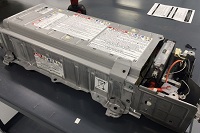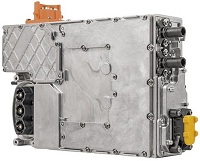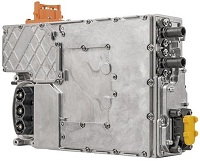Electric vehicle parts
The function and components of an electric automobile or vehicle depend on the kind of car. At least four different types of electric vehicles are now available for purchase and use on the global market (please read the page “Types of Electric Cars, Architecture, and Working Principles”). Inverters (DC-DC converters), traction batteries, traction motors, on-board chargers, and controllers are only a few of the frequent major components, pieces, or aspects of electric cars that will be covered in this article along with their functions. How an electric car operates is determined by the many sorts of electric car components. The components and operations of electric vehicles may be explained using the illustration below.

How Do Electric Cars Operate?
If the gas pedal is depressed while driving:
Batteries [A] and inverters [B] provide the electrical energy that the controller [C] uses and controls.
The inverter then delivers a certain quantity of electrical energy to the motor when the controller is set (according to the depth of pressure on the pedal)
Electrical energy is transformed into mechanical energy by an electric motor (D) (rotation)
The motor’s rotor turns the gearbox, which causes the wheels to revolve and propel the vehicle forward.
Note that the aforementioned operating theory only applies to battery electric vehicles (BEVs).
Electric Vehicle Components
Basic Main Components of Electrical Vehicle
The following are the fundamental components found in practically all forms of electric vehicles.
Pack of Traction Batteries (A)

An electric vehicle’s battery serves as a method for storing electrical energy in the form of direct current (DC). The battery will send DC electrical energy to the inverter if it receives a signal from the controller, which will then be utilised to power the motor. Rechargeable batteries are employed, and they are combined to create a device known as a “traction battery pack.”
Electric car batteries come in a variety of varieties. The lithium-ion battery type is the one that is most frequently utilised. To learn a little bit more about batteries for electric automobiles, please read the article “Electric Car Batteries and Their Characteristics.”
Power Inverter

The inverter transforms the battery’s direct current (DC) into alternating current (AC), which is then utilised to power an electric motor. Additionally, an electric car’s inverter may convert AC to DC current during regenerative braking, which is then utilised to replenish the battery. Bi-directional inverters are the kind of inverter that some electric car models employ.
Controller (C)
The controller’s primary job is to regulate the electrical energy that will be supplied to electric motors from batteries and inverters. While the automobile pedal serves as the primary input for the controller itself (which is set by the driver). The speed of the automobile will be determined by this pedal setting, which will also affect the frequency or voltage fluctuation that will enter the motor.

In a nutshell, this device regulates the flow of electrical energy supplied by the traction battery, regulating the torque and speed of the electric traction motor. How an electric automobile operates will be determined by this element.
Elemental Traction Motor (D)
The electric traction motors will turn the transmission and wheels because the controller supplies electricity from the traction battery. Some hybrid electric vehicles employ a particular kind of generator-motor that serves as both a propulsion and regeneration device. The BLDC (brushless DC) motor is the type of electric motor that is typically utilised.
———————————————
Other Elements of Electric Vehicles
Battery charging equipment is charger (E). Chargers receive their electricity from external sources like solar power plants or the utility grid. The battery is used to store DC power once it has been converted from AC electricity. Electric car chargers come in two varieties:
Elemental Traction Motor (D)
The electric traction motors will turn the transmission and wheels because the controller supplies electricity from the traction battery. Some hybrid electric vehicles employ a particular kind of generator-motor that serves as both a propulsion and regeneration device. The BLDC (brushless DC) motor is the type of electric motor that is typically utilised.
———————————————
Other Elements of Electric Vehicles
Battery charging equipment is charger (E). Chargers receive their electricity from external sources like solar power plants or the utility grid. The battery is used to store DC power once it has been converted from AC electricity. Electric car chargers come in two varieties:
On-board charger: a charger that is mounted within the vehicle
Off-board charger: If the charger is not present or is not set up in

















